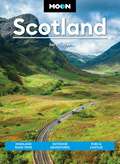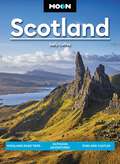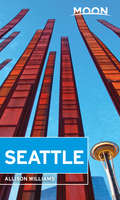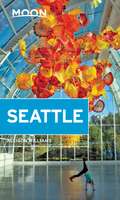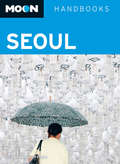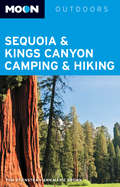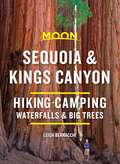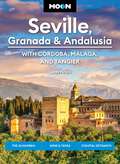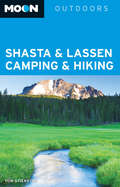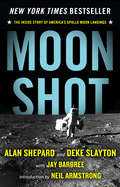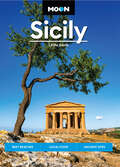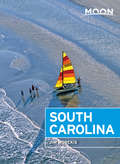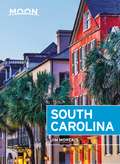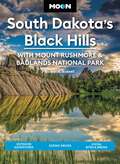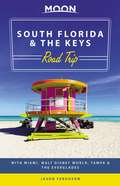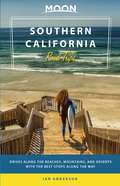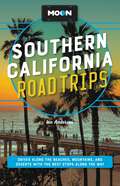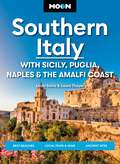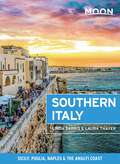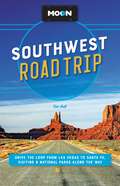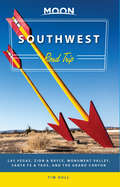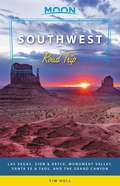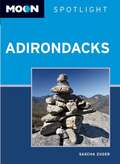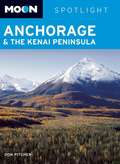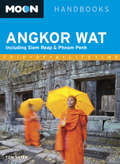- Table View
- List View
Moon Scotland: Highland Road Trips, Outdoor Adventures, Pubs & Castles (Moon Europe Travel Guide)
by Sally Coffey Moon Travel GuidesDramatic landscapes, hauntingly beautiful ruins, and stirring myths and legends: See for yourself why this evocative country has inspired art and folklore for centuries with Moon Scotland. Inside you&’ll find:Flexible itineraries including a journey through the Highlands and islands, day-by-day itineraries in Glasgow and Edinburgh, a tour of Scotland&’s six World Heritage Sites, and more Strategic advice, whether you&’re looking to castle-hop, trace your ancestry, go cliff-diving, or stroll through misty villages Must-see highlights and unique experiences: Walk along Edinburgh's historic Royal Mile, or climb the Arthur's Seat peak. Explore Neolithic burial chambers and rugged archipelagos in the north, follow the Malt Whisky Trail in Speyside, or hop on the West Highland Railway, one of the world&’s most beautiful train rides. Catch a traditional music performance in Glasgow or chat with locals at a corner pub over folk music and a pint. Hike through wild moors and pine forests to deserted villages on Skye, play one of the oldest golf courses in the world, or take a seaplane over Loch Lomond for dramatic views of the Highlands Honest tips from Scotland expert Sally Coffey Full-color photos and detailed maps throughoutBackground information on Scotland&’s landscape, history, and cultural customs In-depth coverage of Edinburgh, Glasgow, Southern, Central, and Northeast Scotland, Loch Lomond, Inverness, Orkney & Shetland, the Central Highlands and the Isle of Skye, and the Outer Hebrides Experience the best of Scotland with Moon&’s practical tips and expert insight. Continuing your journey? Check out Moon Ireland. About Moon Travel Guides: Moon was founded in 1973 to empower independent, active, and conscious travel. We prioritize local businesses, outdoor recreation, and traveling strategically and sustainably. Moon Travel Guides are written by local, expert authors with great stories to tell—and they can't wait to share their favorite places with you. For more inspiration, follow @moonguides on social media.
Moon Scotland: Highland Road Trips, Outdoor Adventures, Pubs and Castles (Travel Guide)
by Sally CoffeyDramatic landscapes, hauntingly beautiful ruins, and stirring myths and legends: See for yourself why this evocative country has inspired art and folklore for centuries with Moon Scotland. Inside you&’ll find:Flexible itineraries including a journey through the Highlands and Islands, day-by-day itineraries in Glasgow and Edinburgh, a tour of Scotland&’s six World Heritage Sites, and more Strategic advice, whether you&’re looking to castle-hop, trace your ancestry, go cliff-diving, or stroll through misty villages Must-see highlights and unique experiences: Walk along Edinburgh's historic Royal Mile, or climb the Arthur's Seat peak. Explore Neolithic burial chambers and rugged archipelagos in the north, follow the Malt Whisky Trail in Speyside, or hop on the West Highland Railway, one of the world&’s most beautiful train rides. Catch a traditional music performance in Glasgow or chat with locals at a corner pub over folk music and a pint. Hike through wild moors and pine forests to deserted villages on Skye, play one of the oldest golf courses in the world, or take a seaplane over Loch Lomond for dramatic views of the Highlands Honest tips from Scotland expert Sally Coffey Full-color photos and detailed maps throughoutBackground information on Scotland&’s landscape, history, and cultural customs Helpful resources on Covid-19 and traveling to Scotland In-depth coverage of Edinburgh, Glasgow, Southern, Central, and Northeast Scotland, Loch Lomond, Inverness, Orkney & Shetland, the Central Highlands and the Isle of Skye, and the Outer Hebrides Handy tools such as visa information, a Scottish phrasebook, and tips for LGBTQ+ travelers, families with kids, and seniors Experience the best of Scotland with Moon&’s practical tips and expert insight. Sticking to the major cities? Check out Moon Edinburgh, Glasgow & the Isle of Skye. About Moon Travel Guides: Moon was founded in 1973 to empower independent, active, and conscious travel. We prioritize local businesses, outdoor recreation, and traveling strategically and sustainably. Moon Travel Guides are written by local, expert authors with great stories to tell—and they can't wait to share their favorite places with you. For more inspiration, follow @moonguides on social media.
Moon Seattle
by Allison WilliamsExperience the Life of the CitySeattle is a world-class metropolis that hasn't outgrown its youthful exuberance. Take in the creative energy, innovative spirit, and optimism of the city with Moon Seattle.The Moon Seattle travel guidebook features:Local author and reporter Allison Williams shares her expert perspective on her adopted cityFull-color guidebooks with striking and useful photosNavigate by neighborhood or by activity with color-coded mapsDetailed itineraries, all accessible by public transit, as well as day trips outside the city: Best of Seattle (4 Days), Seattle with Kids (3 Days), A Rainy Day in Seattle, Best of Tech, Bainbridge Island, Mt. RainierGuided walks through the liveliest neighborhoods, including Downtown and Pioneer Square, Capitol Hill, and Ballard and suggestions on where to eat, drink, and play nearbyStrategic advice on the best ways to see iconic sights, including the top places to take in the view, get drinks, or people-watchActivities and trip ideas for every traveler, such as exploring Seattle's unique coffee culture, sampling some of the country's best craft beer, listening to live music, visiting beautiful museums, shopping downtown, tasting seafood fresh from the Pacific, and enjoying the city skylineAccurate and up-to-date background information on the landscape, history, culture, and artsHelpful tools such as detailed tips on where to stay and an easy-to-read foldout map to use on the go, all in a book light enough to fit in your messenger bagWith Moon Seattle's practical tips, myriad activities, and local insight on the best things to do and see, you can plan your trip your way. Road tripping along the Coast? Test-drive Moon Pacific Northwest Road Trip, or Moon Pacific Coast Highway Road Trip. Visiting more of the state? Check out Moon Washington. Want to experience more city life on the West Coast? Try Moon Portland.
Moon Seattle: Seattle, Vancouver, Victoria, The Olympic Peninsula, Portland, The Oregon Coast & Mount Rainier (Travel Guide)
by Allison WilliamsExplore every corner of the Emerald City, from coffee shops to mountain hikes, with Moon Seattle.Explore the City: Navigate by neighborhood or by activity with color-coded maps, or follow self-guided neighborhood walksSee the Sights: Watch the fishmongers sling the catch of the day at Pike Place Market, or grab a pick-me-up at the original Starbucks. Zig zag through the Olympic Sculpture Park, watch sharks swim above you in the Seattle Aquarium's underwater dome, admire Northwest art at the Seattle Art Museum, or watch the sunset from Space Needle observation deckGet a Taste of the City: Find the best cup of coffee, sample fresh oysters, and indulge in the city's innovative cuisineBars and Nightlife: Lounge at an old-school jazz club, discover the next big indie artist, get a flight of beers at a local microbrewery, or sip craft cocktails in a swanky speakeasyExpert Advice: Emerald City native Allison Williams shares what locals love about SeattleStrategic Itineraries and Day Trips: Make the most of your trip with ideas for foodies, culture-seekers, families traveling with kids, and more, or explore nearby Bainbridge Island, Mount Rainier National Park, Tacoma, and BellevueFull-Color Photos and Detailed MapsHandy Tools: Background information on history and culture, plus an easy-to-read foldout map to use on the goExperience the best of the city with Moon Seattle's practical tips and local know-how.Road tripping along the coast? Test-drive Moon Pacific Northwest Road Trip. Visiting more of the state? Check out Moon Washington.
Moon Seoul
by Jonathan HopfnerJournalist Jonathan Hopfner gives travelers the benefit of his firsthand experience as a Seoul resident, providing honest insight into the many sides of this bustling city. Hopfner outlines entertaining travel strategies for exploring Seoul, including A Walk Through History, Nature in the City Limits, and Seoul with Children. From where to find the best-tasting and most affordable Korean barbecue to which areas are best for shopping and people-watching, Moon Seoul gives travelers the tools they need to create a more personal and memorable experience.
Moon Sequoia & Kings Canyon Camping & Hiking
by Ann Marie Brown Tom StienstraNature lovers Tom Stienstra and Ann Marie Brown invite travelers to experience the deep canyons, tall peaks, and awe-inspiring giant sequoia groves of Sequoia National Forest and Kings Canyon National Park. Stienstra and Brown's expert advice and useful camping and hiking tips makeMoon Sequoia & Kings Canyon Camping & Hikingessential for any trip to this high Sierra paradise; and their "best-of" trail and campground lists-including Best Scenic Destinations, Best for Fall Colors, and Best for Redwoods and Sequoias-ensure that novice and experienced outdoors adventurers alike will be able to plan their perfect expedition. Complete with clear directions to each location, detailed destination descriptions, difficulty and quality ratings for each hike, and helpful maps,Moon Sequoia & Kings Canyon Camping & Hikingprovides campers and hikers with all the necessary tools to head outdoors.
Moon Sequoia & Kings Canyon: Hiking, Camping, Waterfalls & Big Trees (Travel Guide)
by Leigh BernacchiAscend towering peaks, take in awe-inspiring views, and get to know some of the oldest, tallest, and rarest living things on Earth with Moon Sequoia & Kings Canyon. Inside you'll find:Flexible Itineraries: Unique and adventure-packed ideas for day hikers, winter visitors, families with kids, campers, and more The Best Hikes in Each National Park: Detailed hike descriptions, trail maps, mileage and elevation gains, and backpacking optionsExperience the Outdoors: Behold greatness at the base of a giant sequoia, stop and smell the wildflowers of Zumwalt Meadow, or savor panoramic views from the summit of Mount Whitney (the highest peak in the continental US!). Strap on snowshoes for a ranger-led winter walk or spelunk your way around otherworldly rock formations in Crystal Cave. Cool off in the mist of a trailside waterfall, conquer the 400-step climb to the top of Moro Rock, and gaze at ink-black skies with unbeatable views of the Milky WayHow to Get There: Up-to-date information on traveling between the parks, gateway towns, park entrances, park fees, and toursWhere to Stay: From RV or tent campgrounds to rustic cabins and all-inclusive lodges, find the best spots to kick back, both inside and outside the parksPlanning Tips: When to go, what to pack, safety information, and how to avoid the crowds, with full-color photos and easy-to-use maps throughoutExpert Insight: Former national park ranger Leigh Bernacchi provides helpful background on the parks' history, geology, conservation efforts, and moreFind your adventure in Sequoia and Kings Canyon national parks with Moon.Exploring more of America's parks? Check out Moon USA National Parks.
Moon Seville, Granada & Andalusia: The Alhambra, Wine & Tapas, Coastal Getaways (Moon Europe Travel Guide)
by Lucas Peters Moon Travel GuidesFrom stunning palaces and vibrant plazas to snowy mountains and warm beaches, soak up the magic of southern Spain with Moon Seville, Granada & Andalusia. Inside you&’ll find:Strategic, flexible itineraries including a two-week grand tour of Andalusia, shorter trips to the Pueblos Blancos or Costa del Sol, and more Must-see highlights and unique experiences: Wander among the intricate tiles and beautiful gardens of Granada&’s Alhambra and marvel at the soaring arches of Cordoba&’s Mezquita-Catedral. Row a boat through Seville&’s Plaza de España, ski in the Sierra Nevada, or relax on a sunny beach. Enjoy a flamenco performance, experience a Semana Santa procession, or party at Carnival in Cadiz The best local flavors: Savor fresh seafood, sample unique tapas, and feast on jamón ibérico. Cool down with refreshing gazpacho or warm up with churros and piping hot chocolate. Attend an olive oil tasting, tour a sherry bodega, or sip local wine Ideas for side trips, including Malaga, Tangier, Gibraltar, Cadiz, the Pueblos Blancos, and more Expert advice from writer and photographer Lucas Peters, who has spent the past two decades traveling in Europe Full-color photos and detailed maps throughoutBackground information on the landscape, history, and cultural customs of each city Handy tools such as visa information, a Spanish phrasebook, and tips for families, travelers with disabilities, women travelers, travelers of color, LGBTQ+ travelers, and seniors Experience the best of southern Spain your way with Moon Seville, Granada & Andalusia. Exploring more of Europe? Check out Moon Portugal or Moon Sicily. Expanding your trip? Try Moon Morocco.About Moon Travel Guides: Moon was founded in 1973 to empower independent, active, and conscious travel. We prioritize local businesses, outdoor recreation, and traveling strategically and sustainably. Moon Travel Guides are written by local, expert authors with great stories to tell—and they can't wait to share their favorite places with you. For more inspiration, follow @moonguides on social media.
Moon Shasta & Lassen Camping & Hiking
by Tom StienstraAvid outdoors explorer Tom Stienstra invites fellow adventurers to visit the backcountry lakes, volcanic rock, and quiet wilderness, of Shasta and Lassen. Moon Shasta & Lassen Camping & Hiking's easy-to-use format and exhaustive coverage includes "best-of" campground and trail suggestions, such as Best for White-Water Rafting, Best Butt-Kickers, and Best for Wildlife-making it easy for beginner and expert oudoors enthusiasts alike to create the camping and hiking experience they're looking for. Complete with clear directions to each location, detailed destination descriptions, difficulty and quality ratings for each hike, and helpful maps,Moon Shasta & Lassen Camping & Hikingprovides campers and hikers with all the necessary tools to head outdoors.
Moon Shot: The Inside Story of America's Apollo Moon Landings
by Jay Barbree Deke Slayton Alan ShepardNew York Times bestseller for fans of First Man: A &“breathtaking&” insider history of NASA&’s space program—from astronauts Alan Shepard and Deke Slayton (Entertainment Weekly). On October 4, 1957, the Soviet Union launched Sputnik I, and the space race was born. Desperate to beat the Russians into space, NASA put together a crew of the nation&’s most daring test pilots: the seven men who were to lead America to the moon. The first into space was Alan Shepard; the last was Deke Slayton, whose irregular heartbeat kept him grounded until 1975. They spent the 1960s at the forefront of NASA&’s effort to conquer space, and Moon Shot is their inside account of what many call the twentieth century&’s greatest feat—landing humans on another world. Collaborating with NBC&’s veteran space reporter Jay Barbree, Shepard and Slayton narrate in gripping detail the story of America&’s space exploration from the time of Shepard&’s first flight until he and eleven others had walked on the moon.
Moon Sicily: Best Beaches, Local Food, Ancient Sites (Travel Guide)
by Moon Travel Guides Linda SarrisFrom relaxing on sun-soaked beaches to hiking Mount Etna, immerse yourself in la dolce vita with Moon Sicily. Inside you'll find:Flexible itineraries for exploring the best of Sicily, including Palermo, Western Sicily, the Aeolian Islands, Catania, Mount Etna, Syracuse, and more Strategic advice for foodies and oenophiles, art lovers, hikers, history buffs, beach bums, and more Must-see highlights and unique experiences for any season: Go climbing and wine-tasting on scenic Mount Etna. Visit the noble palaces and flourishing outdoor markets of Palermo. Island-hop and soak up the spectacular beaches of the Aegadian Islands. Walk among Greek ruins at the Valle dei Templi and wander romantic towns like Cefalú and Taormina The best local flavors: Savor fresh seafood straight from the Mediterranean, sample locally made sheep cheese, and taste some of Italy&’s best street food in Palermo. Enjoy diverse Sicilian wines like historic marsala and sip a morning cappuccino at a charming café Expert advice from Palermo local and chef Linda Sarris on where to stay, what to eat, and how to get around Full-color photos and detailed maps throughoutBackground information on the landscape, history, and cultural customs Handy tools including an Italian phrasebook and tips for senior travelers, travelers of color, traveling with children, and more With Moon&’s practical tips and local insight on the best things to do and see, you can experience the very best of Sicily. Exploring more of Italy? Check out Moon Southern Italy or Moon Rome, Florence & Venice.About Moon Travel Guides: Moon was founded in 1973 to empower independent, active, and conscious travel. We prioritize local businesses, outdoor recreation, and traveling strategically and sustainably. Moon Travel Guides are written by local, expert authors with great stories to tell—and they can't wait to share their favorite places with you. For more inspiration, follow @moonguides on social media.
Moon South Carolina
by Jim MorekisWriter, editor, and past South Carolina resident Jim Morekis covers the best of the Palmetto State-from the shores of Myrtle Beach to the undeniable charm of Charleston. Morekis includes fun and unique trip ideas for a variety of travelers, including "Carolina for Kids," "Romance in Charleston and the Lowcountry," and "Marshes, Swamps, and White Water" in this helpful guide. Whether you're looking for an extended vacation or a weekend getaway, Moon South Carolina gives travelers the tools they need to create a more personal and memorable experience.
Moon South Carolina (Moon Handbooks Ser.)
by Jim MorekisDiscover South Carolina with Moon Travel Guides!From the creative hub of Charleston to the laidback Lowcountry, see what sets the Palmetto State apart with Moon South Carolina. Inside you'll find:Strategic, flexible itineraries that can be adapted for your budget and timeline, whether you're planning a getaway to the Grand Strand or a long weekend in the Blue Ridge Mountains, or spending a week exploring the whole stateUnique activities and can't-miss highlights: Wander the charming streets of historic Charleston, hear the stories of Civil War battlefields, and learn about South Carolina's important African American history. Canoe down the longest blackwater river on earth, tee off at world-class golf courses, or explore the cypress swamps at Congaree National Park. Kick back at Myrtle Beach, explore rolling sand dunes, or hike the foothills of the Blue Ridge Mountains. Sample smoky barbecue and fried catfish, or mingle with locals over an authentic Lowcountry boilHonest advice from South Carolina expert Jim Morekis on where to eat, where to stay, and how to get aroundFull-color photos and detailed maps throughoutHandy tips for seniors, international visitors, travelers with disabilities, and moreBackground information on South Carolina's history, culture, landscape, and wildlifeFull coverage of Charleston, Myrtle Beach and the Grand Strand, Hilton Head and the Lowcountry, Columbia and the Midlands, and Greenville and the UpstateWith Moon South Carolina's local perspective, myriad activities, and expert know-how, you can plan your trip your way.Exploring the cities of the South? Check out Moon Charleston & Savannah. Craving a beach getaway? Try Moon Coastal Carolinas.
Moon South Dakota's Black Hills: Outdoor Adventures, Scenic Drives, Local Bites & Brews (Travel Guide)
by Laural A. BidwellExperience the open skies of the Badlands, the rolling prairies of the West, and one of America's most famous monuments with Moon South Dakota's Black Hills. Inside you'll find:Flexible itineraries: Unique and adventure-packed ideas for day trips, a week on the road, families with kids, wildlife enthusiasts, and more The best hikes in the Black Hills and Badlands, with individual trail descriptions, elevation gains, and trailheads Experience the outdoors: Go horseback riding, rock climbing, backpacking, kayaking, biking, and more. Say hello to the carved granite faces of the presidents and hike red rock canyons and hills covered in ponderosa pine. Spot bison, elk, and mountain goats and see wild horses roaming the grassy flatlands. Climb the tallest peak east of the Rockies or navigate the underground passages of Wind Cave National Park Respectfully connect with Native American culture: Visit historic sites, galleries, and museums to learn about Lakota history, see the Crazy Horse Memorial, or attend a powwow ceremony to watch traditional dances and sample authentic cuisine How to get there: Up-to-date information on gateway towns, park entrances, park fees, and tours Where to stay: Campgrounds, resorts, hotels, and more Planning tips: When to go, what to pack, safety information, and how to avoid the crowds, with full-color photos and detailed maps throughout Expertise and know-how: Experience the best of this stunning region with Laural A. Bidwell, a local of South Dakota's Black Hills Get to know South Dakota your way with Moon. Craving more of the great outdoors? Check out Moon USA National Parks, Moon Zion & Bryce, or Moon Yellowstone & Grand Teton. About Moon Travel Guides: Moon was founded in 1973 to empower independent, active, and conscious travel. We prioritize local businesses, outdoor recreation, and traveling strategically and sustainably. Moon Travel Guides are written by local, expert authors with great stories to tell—and they can't wait to share their favorite places with you. For more inspiration, follow @moonguides on social media.
Moon South Florida & the Keys Road Trip: With Miami, Walt Disney World, Tampa & the Everglades (Travel Guide)
by Jason FergusonFrom sandy beaches and amusement parks to wild natural beauty, see what keeps visitors coming back to the Sunshine State with Moon South Florida & the Keys Road Trip. Inside you'll find:Maps and Driving Tools: More than 50 easy-to-use maps keep you oriented on and off the highway, along with site-to-site mileage, driving times, detailed directions for the entire route, and full-color photos throughoutEat, Sleep, Stop and Explore: With lists of the best beaches, views, and more, you can explore the lush wetlands of the Everglades, relax on the beautiful beaches of the Keys, let your imagination run wild at Disney World, or soak up the electric vibe of MiamiFlexible Itineraries: Drive the entire two-week road trip or follow strategic routes designed for outdoor adventurers, history buffs, and more, as well as suggestions for spending time in Miami, the Everglades, the Keys, the Atlantic Coast, Orlando, Daytona, the Space Coast, Walt Disney World, Sarasota, and NaplesLocal Expertise: Florida native Jason Ferguson takes you on a tour of his beloved home state Planning Your Trip: Know when and where to get gas and how to avoid traffic, plus tips for driving in different road and weather conditions and suggestions for LGBTQ travelers, seniors, and road-trippers with kidsWith Moon South Florida & the Keys Road Trip's practical tips, flexible itineraries, and local know-how, you're ready to fill up the tank and hit the road.Looking to explore more of America on wheels? Try Moon Nashville to New Orleans Road Trip! Doing more than driving through? Check out Moon Sarasota & Naples or Moon Florida.
Moon Southern California Road Trips: Drives along the Beaches, Mountains, and Deserts with the Best Stops along the Way (Travel Guide)
by Ian AndersonCatch a wave, hike to the Hollywood sign, or soak up some desert sun: the possibilities are endless with Moon Southern California Road Trips. Inside you'll find:Pick Your Road Trip: Find flexible getaways throughout SoCal like three-day routes up the coast, through Death Valley, Ojai, and more, or combine them for an epic two-week driving tourEat, Sleep, Stop and Explore: With lists of the best beaches, hikes, wineries, and more, you can tour backlots in Los Angeles, feel like a kid again at Disneyland, and feast on tacos and craft beer in San Diego. Climb Joshua Tree's rock formations to stunning views, ski and surf in the same day, and get a taste of the laidback lifestyle in Santa Barbara and Palm Springs Maps and Driving Tools: Easy-to-use maps keep you oriented on and off the highway, along with site-to-site mileage, driving times, detailed directions, and full-color photos throughoutLocal Expertise: San Diego native, brew enthusiast, and avid surfer Ian Anderson shares his tips on where to stop and what to see How to Plan Your Trip: Know when and where to get gas and how to avoid traffic, plus tips for driving in different road conditions and suggestions for LGBTQ travelers, seniors, and road-trippers with kidsCoverage of Los Angeles, Disneyland, beaches from Malibu to La Jolla, San Diego, Anza Borrego State Park, Palm Springs & Joshua Tree, Route 66, Santa Barbara, San Luis Obispo, and Hearst Castle, plus Las VegasWith flexible itineraries for weekend getaways and practical tips for driving the full loop, Moon Southern California Road Trips gets you ready to fill up the tank and hit the road.Looking for more coverage of Southern California? Check out Moon San Diego or Moon Los Angeles. Want to extend your adventure? Check out Moon Northern California Road Trips.
Moon Southern California Road Trips: Drives along the Beaches, Mountains, and Deserts with the Best Stops along the Way (Travel Guide)
by Ian AndersonHit the beach, hike hidden trails, or soak up some desert sun: the outdoor adventures are endless with Moon Southern California Road Trips.Pick Your Road Trip: Find flexible getaways throughout SoCal like three-day routes up the coast, through Death Valley, Ojai, and more, or combine them for an epic two-week driving tour Eat, Sleep, Stop and Explore: With lists of the best beaches, hikes, wineries, and more, you can tour backlots in Los Angeles, feel like a kid again at Disneyland, and feast on tacos and craft beer in San Diego. Climb Joshua Tree's rock formations to stunning views, ski and surf in the same day, and get a taste of the laidback lifestyle in Santa Barbara and Palm Springs Maps and Driving Tools: Easy-to-use maps keep you oriented on and off the highway, along with site-to-site mileage, driving times, detailed directions, and full-color photos throughout Local Expertise: San Diego native, brew enthusiast, and avid surfer Ian Anderson shares his tips on where to stop and what to see How to Plan Your Trip: Know when and where to get gas and how to avoid traffic, plus tips for driving in different road conditions and suggestions for LGBTQ travelers, seniors, travelers of color, and road-trippers with kids Coverage of Los Angeles, Disneyland, beaches from Malibu to La Jolla, San Diego, Anza Borrego State Park, Palm Springs & Joshua Tree, Route 66, Santa Barbara, San Luis Obispo, and Hearst Castle, plus Las Vegas With flexible itineraries for weekend getaways and practical tips for driving the full loop, Moon Southern California Road Trips gets you ready to fill up the tank and hit the road. Spending more time in the city? Check out Moon 52 Things to Do in Los Angeles. Want to extend your adventure? Check out Moon Northern California Road Trips.
Moon Southern Italy: Best Beaches, Local Food & Wine, Ancient Sites (Moon Europe Travel Guide)
by Laura Thayer Moon Travel Guides Linda SarrisFrom the pastel rooftops of Positano to the soaring peak of Mount Etna, immerse yourself in la dolce vita with Moon Southern Italy. Inside you'll find:Flexible itineraries for exploring the best of Southern Italy, including Naples, Pompeii, Sicily, Puglia, the Amalfi Coast, and more, that can be combined for a longer trip Must-see highlights and unique experiences for any season: Dive into the art museums and traditional theater of Palermo&’s Centro Storico and admire the Baroque monuments and carved churches of Lecce. Walk the frozen-in-time streets of Pompeii and marvel at the captivating Cathedral of Amalfi. Take an off-road Jeep tour of Mount Etna or hike along the coastline. Soak up the sun on a secluded beach or sail the crystal-clear Mediterranean waters The best local flavors: Stroll quiet village streets where the scent of Sunday ragu fills the air, feast on fresh seafood from a bustling outdoor market, and chow down on authentic Neapolitan pizza. Sip limoncello on a sunny terrace or sample wines from the mineral-rich local vineyards Expert suggestions from local authors Laura Thayer and Linda Sarris on where to stay, what to eat, and how to get around Full-color photos and detailed maps throughoutBackground information on the landscape, history, and cultural customs, plus an Italian phrasebook With Moon&’s practical tips and local insight on the best things to do and see, you can experience the very best of Southern Italy. Exploring more of Italy? Check out Moon Rome, Florence & Venice.About Moon Travel Guides: Moon was founded in 1973 to empower independent, active, and conscious travel. We prioritize local businesses, outdoor recreation, and traveling strategically and sustainably. Moon Travel Guides are written by local, expert authors with great stories to tell—and they can't wait to share their favorite places with you. For more inspiration, follow @moonguides on social media.
Moon Southern Italy: Sicily, Puglia, Naples & the Amalfi Coast (Travel Guide)
by Laura Thayer Linda SarrisFrom the pastel rooftops of Positano to the soaring peak of Mount Etna, immerse yourself in la dolce vita with Moon Southern Italy. Inside you'll find:Flexible itineraries for exploring the best of Southern Italy, including Sicily, Puglia, Naples, the Amalfi Coast, and more, that can be combined for a longer trip Strategic advice for foodies and oenophiles, art lovers, hikers, history buffs, beach bums, and more Must-see highlights and unique experiences for any season: Dive into the art museums and traditional theater of Palermo&’s Centro Storico, and admire the Baroque monuments and carved churches of Lecce. Walk the frozen-in-time streets of Pompeii and marvel at the captivating Cathedral of Amalfi. Take an off-road Jeep tour of Mount Etna or hike along the coastline. Soak up the sun on a secluded beach or sail the crystal-clear Mediterranean waters The best local flavors: Stroll quiet village streets where the scent of Sunday ragu fills the air, feast on fresh seafood from a bustling outdoor market, and chow down on authentic Neapolitan pizza. Sip limoncello on a sunny terrace or sample wines from the mineral-rich local vineyards Expert suggestions from Amalfi local Laura Thayer and Palermo local Linda Sarris on where to stay, where to eat, and how to get around Full-color photos and detailed maps throughoutHelpful resources on COVID-19 and traveling to Southern Italy Background information on the landscape, history, and cultural customs Handy tools including an Italian phrasebook and tips for seniors and traveling with children With Moon&’s practical tips and local insight on the best things to do and see, you can experience the very best of Southern Italy. Exploring more of Italia? Check out Moon Milan & Beyond with the Italian Lakes or Moon Rome, Florence & Venice. About Moon Travel Guides: Moon was founded in 1973 to empower independent, active, and conscious travel. We prioritize local businesses, outdoor recreation, and traveling strategically and sustainably. Moon Travel Guides are written by local, expert authors with great stories to tell—and they can't wait to share their favorite places with you. For more inspiration, follow @moonguides on social media.
Moon Southwest Road Trip: Drive the Loop from Las Vegas to Santa Fe, Visiting 8 National Parks along the Way (Travel Guide)
by Tim HullWind-carved red rocks, brightly-painted adobe houses, and miles of open desert road: explore the beauty of the Southwest with Moon Southwest Road Trip. Inside you'll find:Flexible itineraries: Drive the entire two-week road trip, or follow strategic routes like a Route 66 road trip or a week-long tour of the national parks, or plan a shorter getaway to Las Vegas, the Grand Canyon, Zion and Bryce, Arches and Canyonlands, Santa Fe, or TaosEat, sleep, stop and explore: With lists of the best hikes, views, and more, you can marvel at the sandstone spires of Monument Valley and the cliff dwellings of Mesa Verde National Park, go mountain biking in Moab, or swimming in Havasu Falls. Revel in the glitz of Las Vegas, shop the markets of Santa Fe, and dig in to delicious southwestern cuisine Maps and driving tools: 32 easy-to-use maps keep you oriented on and off the highway, along with site-to-site mileage, driving times, detailed directions for the entire route, and full-color photos throughout Local expertise: Road warrior and Arizona local Tim Hull shares his love of the Southwest (including where to find the best fiery chiles!) Planning your trip: Know when and where to get gas, how to avoid traffic, tips for driving in different road and weather conditions With Moon Southwest Road Trip's practical tips, flexible itineraries, and local know-how, you're ready to fill up the tank and hit the road. Looking for more scenic road trips in America? Try The Open Road. Spending more time in the Southwest? Check out Moon Arizona & the Grand Canyon, Moon New Mexico, or Moon Utah.About Moon Travel Guides: Moon was founded in 1973 to empower independent, active, and conscious travel. We prioritize local businesses, outdoor recreation, and traveling strategically and sustainably. Moon Travel Guides are written by local, expert authors with great stories to tell—and they can't wait to share their favorite places with you. For more inspiration, follow @moonguides on social media.
Moon Southwest Road Trip: Las Vegas, Zion & Bryce, Monument Valley, Santa Fe & Taos, and the Grand Canyon
by Tim HullHIT THE ROAD!See the top destinations in the Southwest with this book as your guide. With 32 easy-to-use maps keep you oriented on and off the highway, our detailed driving routes give you all you need, including mileage from place to place, driving times, and advice on the best stops along the way to eat, sleep, and explore.Choose the road trip that's best for you:The 14-Day Best of the SouthwestLas Vegas, Utah's National Parks, and the Grand CanyonTwo Days along Route 66Two Days in Las VegasOne Day at the Grand CanyonAlso AvailableMoon Zion & BryceMoon Route 66 Road Trip
Moon Southwest Road Trip: Las Vegas, Zion & Bryce, Monument Valley, Santa Fe & Taos, and the Grand Canyon (Travel Guide)
by Tim HullWind-carved red rocks, brightly-painted adobe houses, and miles of open desert road: explore the beauty of the Southwest with Moon Southwest Road Trip.Maps and Driving Tools: More than 30 easy-to-use maps keep you oriented on and off the highway, along with site-to-site mileage, driving times, detailed directions for the entire route, and full-color photos throughoutEat, Sleep, Stop and Explore: With lists of the best hikes, views, and more, you can revel in the glitz of Las Vegas, shop the markets of Santa Fe, and savor flavorful Tex-Mex cuisine. Marvel at the sandstone spires of Monument Valley and the cliff dwellings of Mesa Verde National Park, or go mountain biking in Moab or swimming in Havasu FallsFlexible Itineraries: Drive the entire two-week road trip, or follow strategic routes like a Route 66 road trip or a week-long tour of the national parks, as well as suggestions for spending time in Las Vegas, the Grand Canyon, Zion and Bryce, Arches and Canyonlands, Santa Fe, and TaosLocal Expertise: Road warrior and Arizona local Tim Hull shares his love of the Southwest How to Plan Your Trip: Know when and where to get gas and how to avoid traffic, plus tips for driving in different road and weather conditions and tips for seniors, road-trippers with kids, and disability accessMoon Southwest Road Trip covers: New Mexico, Colorado, Utah, Arizona, and Nevada With Moon Southwest Road Trip's practical tips, flexible itineraries, and local know-how, you're ready to fill up the tank and hit the road.Looking to explore more of America on wheels? Try Moon California Road Trip. Spending more time in the Southwest? Check out Moon Arizona & the Grand Canyon, Moon New Mexico, or Moon Utah.
Moon Spotlight Adirondacks
by Sascha ZugerMoon Spotlight Adirondacks is a 70-page compact guide covering the best of the Adirondacks, including the Fort Ticonderoga, the Hyde Collection, the Olympic Ski Jump Complex, and Sackets Harbor. Seasoned traveler and author Sascha Zuger offers her firsthand advice on must-see attractions and activities, and sightseeing highlight maps make planning your time easy. This lightweight guide is packed with recommendations on entertainment, shopping, recreation, accommodations, food, and transportation, making navigating this vast, unusual refuge uncomplicated and enjoyable.
Moon Spotlight Anchorage and the Kenai Peninsula
by Don PitcherMoon Spotlight Anchorage and the Kenai Peninsula is a 132-page compact guide covering the highlights of Anchorage and the Kenai peninsula, including Chugach State Park, the Matanuska-Susitna Valley, Seward, and Homer. Author Don Pitcher offers his firsthand advice on must-see attractions and activities, and sightseeing highlight maps make planning your time easy. This lightweight guide is packed with recommendations on entertainment, shopping, recreation, accommodations, food, and transportation, making navigating these striking destinations uncomplicated and enjoyable.
Moon Spotlight Angkor Wat
by Tom VaterMoon Spotlight Angkor Wat is a 60-page compact guide covering the best of this Cambodian city, including the remaining temples of Angkor-Phnom Wat Bakheng, Thomanon, and Neak Pean. Travel journalist and screenwriter Tom Vater offers his firsthand advice on what sights are must-sees, and sightseeing highlight maps make planning your time easy. This lightweight guide is packed with recommendations on sights, entertainment, shopping, recreation, accommodations, food, and transportation. Helpful maps guide travelers through this richly-historical region of Cambodia. This Spotlight guidebook is excerpted from Moon Cambodia.
